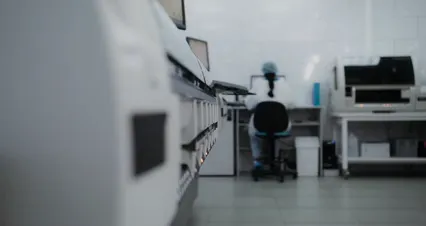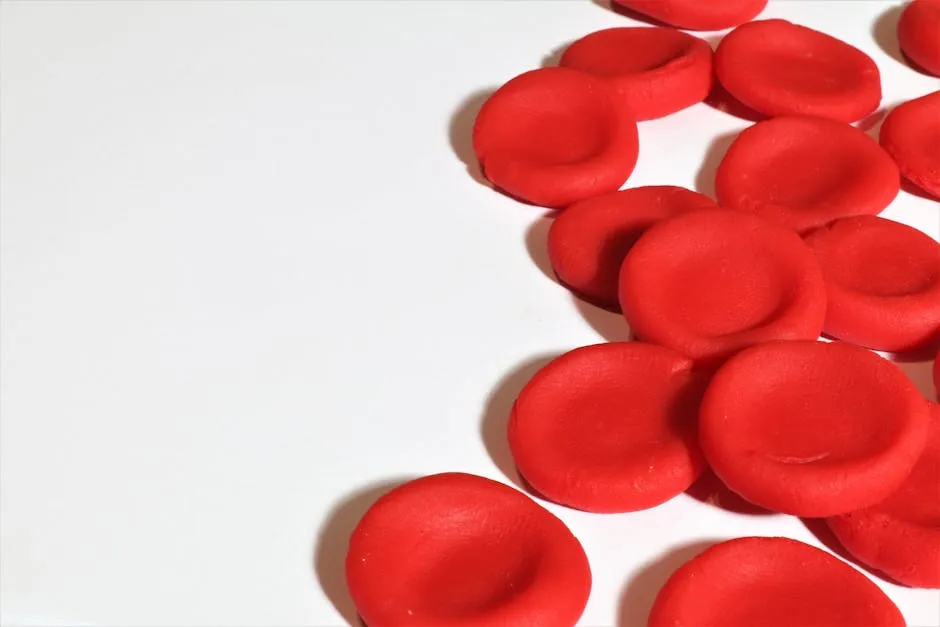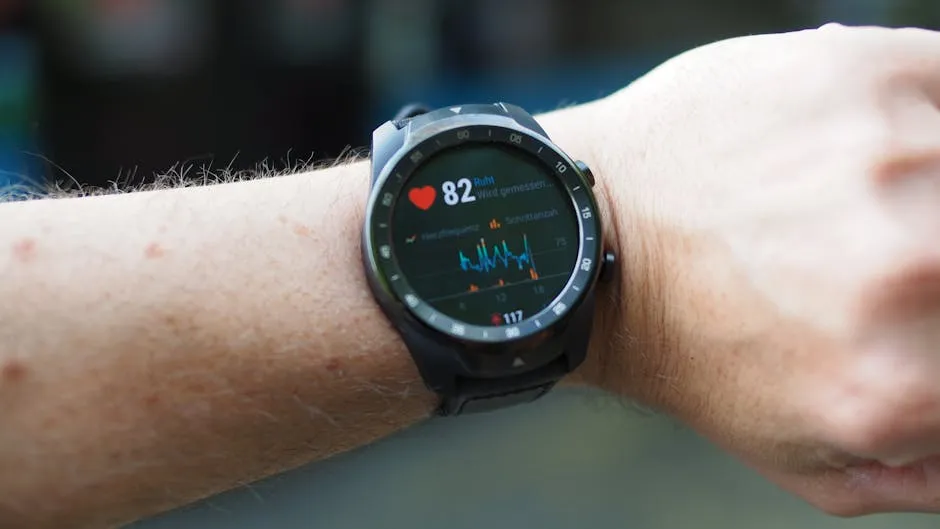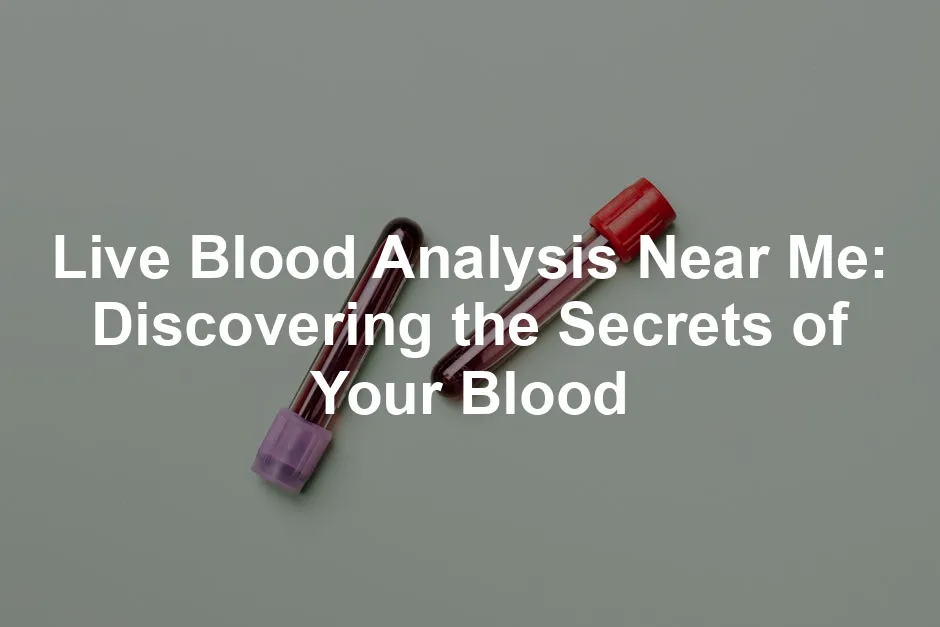Introduction
Live blood analysis is a captivating technique that lets you observe your blood in real-time. Imagine witnessing your blood cells perform a little dance on a screen, revealing insights into your health that you may never have considered. This unique diagnostic method can highlight potential nutritional deficiencies, stress indicators, and even early signs of illness—all from just a tiny drop of blood.
But how do you find the best “live blood analysis near me” when so many clinics are jumping on the bandwagon? Fear not! In this comprehensive guide, we’ll walk you through what live blood analysis entails, its numerous benefits, and tips on finding a reputable provider nearby.
First, let’s break down the process. A small drop of blood is taken from your fingertip and analyzed under a specialized microscope. This allows both the practitioner and you to view the blood cells interacting in real-time. The microscope can magnify the blood up to 10,000 times, providing a detailed look at your cellular health.

Speaking of health, why not boost your overall wellness with an Organic Green Superfood Powder? Packed with nutrients, it’s the perfect addition to your daily routine, helping you feel energized and ready to tackle whatever life throws your way!
As you watch, you may notice your blood cells behaving in ways that could signal issues. This process not only provides immediate feedback but can also empower you to make informed health decisions. Picture this: instead of waiting days for lab results, you can gain insights about your health in mere minutes!
While the idea of watching your blood cells live may seem a bit sci-fi, it can reveal a wealth of information about your overall health. With so many clinics offering live blood analysis, how do you sift through the options? We’ll guide you in identifying trustworthy providers, ensuring that your health is in good hands. Ready to uncover the secrets of your blood? Let’s dive in!
What is Live Blood Analysis?
Definition and Overview
Live blood analysis (LBA) is a fascinating technique that examines your blood while it’s still living. Using a tiny drop of blood, this method aims to provide insights into your overall health. The primary purpose of LBA is to assess your blood cells’ condition and behavior, potentially revealing nutritional deficiencies, immune system issues, and more.
This practice dates back to around 1925, thanks to the pioneering work of German biologist Günther Enderlein. He believed that observing live blood could uncover vital information about a person’s health. Over the years, other proponents, like Robert O. Young, have contributed to its popularity within alternative medicine circles. However, it’s important to note that while many advocate for its benefits, LBA lacks widespread scientific validation.

To optimize your health journey, consider incorporating a Health and Wellness Journal. Track your meals, moods, and progress as you embark on your wellness journey, gaining insight into what works best for you!
How It Works
The process of live blood analysis is quite straightforward. First, a small drop of blood is taken from your fingertip, usually with a simple prick. This blood is then placed on a microscope slide. A specialized darkfield microscope, capable of magnifying the blood up to 10,000 times, is used. This advanced technology allows both the practitioner and you to observe the blood cells in real time on a large screen.
During the analysis, various characteristics of the blood cells are scrutinized. Practitioners look at the shape, size, and movement of the cells, all of which can indicate underlying health issues. The entire session typically lasts around 30 minutes, providing an informative snapshot of your blood’s health.

What Can It Reveal?
Live blood analysis can reveal a plethora of key indicators about your health. For instance, the shape and size of red blood cells might indicate nutritional imbalances. If they appear clumped together, it could signal dehydration or inflammation. The movement of white blood cells can shed light on your immune system’s activity, helping to identify any potential issues.
In addition, the presence of various cellular debris in the blood can point to toxins or heavy metals. Observing these factors can provide valuable insights into your overall health and potential health risks, enabling you to take proactive steps toward wellness. Whether you’re curious about nutritional deficiencies or immune function, LBA can offer a fascinating glimpse into the inner workings of your body.

And speaking of proactive steps, why not invest in your health with a Nutritional Supplement? They can help fill any gaps in your diet and support your overall well-being!
Finding Live Blood Analysis Services Near You
Researching Providers
Searching for local clinics offering live blood analysis can feel like finding a needle in a haystack. But don’t panic! Start with a simple Google search for “live blood analysis near me.” This will give you a list of potential clinics. Check their websites for information on services, technology, and practitioner qualifications.
Social media is another goldmine. Check local wellness groups or health forums. Ask for recommendations. Nothing beats a personal referral!
Once you have a list, dive deeper. Check reviews and ratings on platforms like Yelp or Google. Look for feedback on the environment, professionalism, and results. A clinic with consistently high ratings is a good sign.
Don’t forget to check credentials. Ensure practitioners are certified and have experience. Some clinics may even display their qualifications online. If not, don’t hesitate to ask!

To stay hydrated during your health journey, consider a stylish Reusable Water Bottle. Staying hydrated is crucial for overall health, and having a chic bottle by your side makes it easier!
Key Questions to Ask
When you contact potential providers, gather information with these essential questions:
- What technology do you use? Knowing if they use advanced darkfield microscopy is crucial. This impacts the quality of your analysis.
- What qualifications do your practitioners have? Ensure the person analyzing your blood has proper training in live blood analysis.
- How long does the appointment last? A thorough analysis should take around 30 minutes to an hour.
- What will I see during the analysis? Understanding the process will help you know what to expect.
- Can I have a report after the analysis? A good clinic should provide a detailed report of your findings.
- What is the follow-up process? Knowing how they plan to address findings is essential for your health journey.

What to Expect During Your Appointment
You’ve made it to your appointment! Here’s what to expect. First, you’ll have a brief consultation. The practitioner will ask about your health history, lifestyle, and any concerns you may have.
Next, a small drop of blood is taken from your fingertip. This isn’t the most glamorous part, but it’s quick and usually painless. The blood is placed on a slide and viewed under a darkfield microscope.
During the analysis, you’ll see your blood cells on a monitor, moving and interacting. It’s like a live performance! The practitioner will interpret the results, discussing what they see and how it relates to your health.
Finally, you’ll receive a report summarizing the findings and any recommended lifestyle changes. This is your roadmap to better health!

Cost Considerations
Ah, the million-dollar question: how much does live blood analysis cost? Prices can vary widely based on location and clinic. Generally, expect to pay between $65 to $230 for an analysis.
Some clinics may include additional services, like follow-up consultations or nutritional guidance, in the price. Be sure to inquire about what’s included in the cost.
While it may seem steep, consider it an investment in your health. After all, understanding your body’s needs can lead to better wellness outcomes. You might also want to consider a Blood Test Kit for at-home testing, giving you even more insights into your health!
By doing your homework and asking the right questions, you’ll find a reputable live blood analysis provider that meets your needs. So, roll up your sleeves and let the adventure begin!

Personal Experiences and Testimonials
Real Stories
Live blood analysis may sound like a scene from a sci-fi movie, but it’s a real experience for many. Let’s hear what people have to say about it.
Susan, a wellness enthusiast, shared her journey: “I stepped into the clinic, curious but skeptical. Watching my blood live on a screen was surreal! The practitioner explained everything clearly. I learned about my nutritional deficiencies and took actionable steps afterward. It was empowering!”
On the flip side, we have Mark, who was less impressed: “I had high hopes for my live blood analysis. Unfortunately, the practitioner seemed rushed. I didn’t get the detailed insights I expected. It felt more like a gimmick than a serious health tool.”
Then there’s Lisa. She had a different experience: “I loved it! The clinic was cozy, and the practitioner was knowledgeable. I learned about oxidative stress and how to adjust my diet. Plus, seeing my blood cells in action was fascinating. I recommend it to anyone curious about their health!”
However, not all stories are glowing. Tom remarked, “I was intrigued but left feeling confused. The results were vague, and I didn’t receive a follow-up plan. I expected more guidance on how to improve my health.”
These testimonials highlight the diverse experiences people have with live blood analysis. While many find it enlightening and valuable, others may feel it lacks depth or clarity.

Expert Opinions
Health practitioners have mixed feelings about live blood analysis. Dr. Jane, a holistic health expert, supports it: “Live blood analysis can provide unique insights. It allows us to visualize cellular health and make personalized recommendations.”
Conversely, Dr. Smith, a conventional medicine advocate, warns against it: “While it’s visually captivating, live blood analysis lacks scientific backing. It shouldn’t replace traditional testing methods. Misinterpretations can occur, leading to unnecessary worry.”
These contrasting views illustrate the ongoing debate surrounding live blood analysis. Some practitioners embrace its potential while others urge caution. It’s essential to consider these perspectives when exploring this intriguing method of health assessment.

Conclusion
In conclusion, live blood analysis presents a unique and intriguing approach to understanding our health at a cellular level. While it offers potential insights into nutritional and lifestyle factors, it’s essential to approach this practice with an informed mindset. By carefully selecting a reputable provider and understanding both the benefits and limitations of live blood analysis, you can unlock valuable knowledge about your body.
As you embark on your health journey, remember that this practice is just one of many tools available for achieving optimal wellness. Your health is a puzzle, and live blood analysis can be a piece of that puzzle, not the whole picture. Stay curious, stay informed, and keep exploring the fascinating world of your health!

FAQs
What is the difference between live blood analysis and standard blood tests?
Live blood analysis (LBA) and standard blood tests differ significantly in methodology and insights. Standard tests involve blood drawn from veins, processed in labs, and provide a detailed report after a few days. In contrast, LBA uses a drop of blood taken from a fingertip and analyzed immediately under a microscope. This instant visualization allows you to see live blood cells interacting, providing insights into your cellular health. Standard tests focus on specific markers, like cholesterol or glucose levels, while LBA assesses overall blood cell behavior. For instance, LBA can reveal nutritional deficiencies by examining cell shape and movement. While standard tests are crucial for diagnosing medical conditions, LBA offers a more holistic view of your health, making it a fascinating complement rather than a replacement.
Is live blood analysis suitable for everyone?
Live blood analysis isn’t a one-size-fits-all procedure. While many people can benefit, certain individuals should approach it with caution. Those with bleeding disorders, compromised immune systems, or specific medical conditions should consult their healthcare provider before undergoing LBA. However, if you’re curious about your health or looking for insights into your lifestyle choices, LBA might be just what you need. It can be especially beneficial for health enthusiasts and those seeking to optimize their wellness through dietary and lifestyle adjustments. Always discuss your health history with a practitioner to ensure LBA is a suitable option for you.
How often should I have a live blood analysis?
The frequency of live blood analysis varies based on your health goals and needs. For those exploring dietary changes or improving overall wellness, a session every three to six months may suffice. This timeline allows you to monitor progress and adjust strategies accordingly. If you’re dealing with specific health concerns, more frequent analyses can provide valuable insights. However, it’s essential to balance this with other forms of health monitoring and advice from healthcare professionals. No need to go overboard—your blood doesn’t need a monthly spotlight!
Can I use live blood analysis as a diagnostic tool?
While live blood analysis offers intriguing insights, it is not a substitute for formal medical diagnostics. LBA can highlight potential issues, such as nutritional deficiencies or signs of inflammation, but it lacks the scientific validation and specificity of standard tests. Think of LBA as a conversation starter about your health. It can guide you toward lifestyle changes and dietary adjustments, but any serious health concerns should still be addressed through conventional medical testing. Use LBA to complement your health journey, not as the primary decision-maker.
Are there any risks involved?
Live blood analysis is generally safe, but there are some potential risks. The main concern is the small discomfort from the finger prick, similar to getting a vaccine. Most people find it quick and tolerable. However, improper technique can lead to contamination or misinterpretation of results. Always choose a reputable clinic with qualified practitioners to minimize these risks. While the analysis itself poses little danger, it’s essential to approach any health procedure with awareness and caution. Your health is worth it!
Please let us know what you think about our content by leaving a comment down below!
Thank you for reading till here 🙂
If you’re looking for local providers, a simple search for live blood analysis near me can yield helpful results.
All images from Pexels




